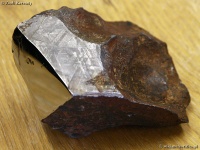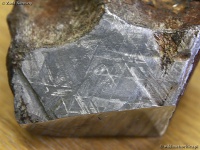(Unless otherwise stated, the copyright of the materials included belong to Jan Woreczko & Wadi.)
Kaposfüred
Z Wiki.Meteoritica.pl
| Linia 1: | Linia 1: | ||
__NOTOC__ | __NOTOC__ | ||
| + | {{VerifyLevel |level=0i}} | ||
{{InfoboxMeteorite | {{InfoboxMeteorite | ||
| nazwa = Kaposfüred | | nazwa = Kaposfüred | ||
| Linia 17: | Linia 18: | ||
| synonimy = | | synonimy = | ||
}} | }} | ||
| - | Doniesienie o | + | Doniesienie o „spadku” meteorytu żelaznego 7 maja 1995 roku (niedziela) na [[Węgry|Węgrzech]]. Meteoryt został zarejestrowany warunkowo (''provisional'') w Meteoritical Bulletin, jako nieudokumentowany spadek ('''''Undocumented'''''). Okaz rzeczywiście jest meteorytem, ale okoliczności jego „spadku”, są mocno wątpliwe! |
| - | Historia | + | Historia „spadku” za Bérczi et al. (1998): |
| - | {{ | + | {{BQuote-begin |max-width=1000px}} |
'''Abstract:''' An iron meteorite fell in Kaposfüred, Somogy County, Hungary, on May 7, 1995, at 3 a.m. (geographical coordinates are: 17°46'E longitude and 46°25'N latitude). The meteorite arrived from NE direction with high inclination path and excavated a ca. 1 meter deep crater in the garden of a local priest. The mass of the meteorite is 2.2 kg, its density is 8.14 g/cm³. INAA studies showed, that Kaposfüred belongs to the IVA group of irons. | '''Abstract:''' An iron meteorite fell in Kaposfüred, Somogy County, Hungary, on May 7, 1995, at 3 a.m. (geographical coordinates are: 17°46'E longitude and 46°25'N latitude). The meteorite arrived from NE direction with high inclination path and excavated a ca. 1 meter deep crater in the garden of a local priest. The mass of the meteorite is 2.2 kg, its density is 8.14 g/cm³. INAA studies showed, that Kaposfüred belongs to the IVA group of irons. | ||
| - | '''The history of the fall:''' On the evening of May 6, 1995 Marcell Török<ref>przypadkowa zbieżność nazwiska ze znanym badaczem węgierskich meteorytów Józsefem Török (węg. ''Józef Turecki'')</ref>, priest of the Kaposszerdahely Roman Catholic parish, decided to get up at dawn to scythe the grass in his garden. Having awoken by some brightness outside he opened his door and suddenly observed an impact of a bright object at a distance of 7-8 meters in his garden. He felt the turbulence caused by the incoming body and observed its shining tail, but right then he closed the door. Since all this happened during the time of the Bosnian war, his first idea was that a projectile hit his garden. According to his watch it was 3 a.m. He went back to sleep and waited for the dawn. After about 2 hours, at dawn, he woke up and went out to see the object. He found that the impacted body had thrown out the soil towards the west, in the direction of the Kaposvár–Fonyód railway line. The diameter of the crater was about 1.5 meter with a depth of 1.1 meter. It was elongated towards the west, in accordance with the east–northeast arrival direction of the falling body. Mr. Török also observed that the object cut down the peak of a pine and melted his aluminium washing line. When Mr. Török tried to take out the object from the bottom of the crater, it melted his spade. Finally he managed to lift the two-fist-sized metallic body out of the crater and put it into a pail of water, which was immediately evaporated. | + | '''The history of the fall:''' On the evening of May 6, 1995, Mr. Marcell Török<ref name="Török">przypadkowa zbieżność nazwiska ze znanym badaczem węgierskich meteorytów Józsefem Török (węg. ''Józef Turecki'')</ref>, a parish reverend of the Kaposszerdahely Roman Catholic Parochy (priest of the Kaposszerdahely Roman Catholic parish), decided that he would get up early in the morning to scythe the grass in his garden. Next dawn he was awakened by some brightness outside and while opening the door he observed the impact of a bright object at a distance of 7-8 m in his garden. He felt the turbulence caused by the incoming body and observed its shining tail. Since all this happened during the Bosnian war, his first idea was that a projectile had landed. He consulted his watch: it was 3 a. m. He went back to sleep and about 2 hours later he examined the mysterious object and found that it had dug up the soil in East-West direction. (He found that the impacted body had thrown out the soil towards the west, in the direction of the Kaposvár–Fonyód railway line). The diameter of the crater was about 1.5 meter and its depth was 1.1 meter. The crater was elongated towards Western direction and this fact signified the East-North-East arrival path. He also observed, that the projectile had decapitated one of his pine trees and melted the aluminium washing line. Then the priest tried to take out the object from the crater which melted his spade. Finally he managed to excavate it and put it in a bucket of water which was evaporated immediately. |
| - | {{ | + | <!-- Wg portalu Muzeum Historii Naturalnej w Budapeszcie: |
| + | On the evening of May 6, 1995 Marcell Török<ref name="Török">przypadkowa zbieżność nazwiska ze znanym badaczem węgierskich meteorytów Józsefem Török (węg. ''Józef Turecki'')</ref>, priest of the Kaposszerdahely Roman Catholic parish, decided to get up at dawn to scythe the grass in his garden. Having awoken by some brightness outside he opened his door and suddenly observed an impact of a bright object at a distance of 7-8 meters in his garden. He felt the turbulence caused by the incoming body and observed its shining tail, but right then he closed the door. Since all this happened during the time of the Bosnian war, his first idea was that a projectile hit his garden. According to his watch it was 3 a.m. He went back to sleep and waited for the dawn. After about 2 hours, at dawn, he woke up and went out to see the object. He found that the impacted body had thrown out the soil towards the west, in the direction of the Kaposvár–Fonyód railway line. The diameter of the crater was about 1.5 meter with a depth of 1.1 meter. It was elongated towards the west, in accordance with the east–northeast arrival direction of the falling body. Mr. Török also observed that the object cut down the peak of a pine and melted his aluminium washing line. When Mr. Török tried to take out the object from the bottom of the crater, it melted his spade. Finally he managed to lift the two-fist-sized metallic body out of the crater and put it into a pail of water, which was immediately evaporated. --> | ||
| + | {{BQuote-end}} | ||
| - | '''Okaz wygląda na za | + | '''Okaz wygląda na za bardzo zwietrzały, jak na świeży spadek! Cała ta historia pełna jest niedorzecznych, wręcz absurdalnych faktów!''' Świadkiem „spadku” był ksiądz Marcell Török!<ref name="Török"></ref> ''No comment''. |
== Lokalizacja == | == Lokalizacja == | ||
| Linia 46: | Linia 49: | ||
{{GEFrame-end}} | {{GEFrame-end}} | ||
| - | Meteoryt spadł na | + | Meteoryt spadł na teren plebani, w miejscu o współrzędnych '''46°24′47,47″N, 17°46′45,29″E'''. |
<br clear="all"/> | <br clear="all"/> | ||
| Linia 52: | Linia 55: | ||
== Galerie == | == Galerie == | ||
| - | Masa główna (fot. Zsolt Kereszty | + | Masa główna (fot. Zsolt Kereszty, ''za zgodą'') |
<gallery caption="" widths="200px" heights="150px" perrow="3"> | <gallery caption="" widths="200px" heights="150px" perrow="3"> | ||
File:Kaposfüred_(Main_Mass)_01.jpg|Wypolerowana i częściowo wytrawiona powierzchnia meteorytu | File:Kaposfüred_(Main_Mass)_01.jpg|Wypolerowana i częściowo wytrawiona powierzchnia meteorytu | ||
Wersja z 22:09, 23 lut 2015
| Kaposfüred → | |
| Spadek nieudokumentowany (Undocumented) | |
| Lokalizacja | Kaposfüred, Kaposvár, Węgry |
| Położenie[1] | 46°25'N, 17°46'E |
| Data | 7 maja 1995 r., 03:00 (niedziela) |
| Uwagi | meteoryt został zarejestrowany warunkowo (provisional) |
| Charakterystyka | |
| Typ | meteoryt żelazny IVA |
| Masa | 2,2 kg |
| Liczba okazów | 1 okaz |
| Meteoritical Bulletin Database | |
Doniesienie o „spadku” meteorytu żelaznego 7 maja 1995 roku (niedziela) na Węgrzech. Meteoryt został zarejestrowany warunkowo (provisional) w Meteoritical Bulletin, jako nieudokumentowany spadek (Undocumented). Okaz rzeczywiście jest meteorytem, ale okoliczności jego „spadku”, są mocno wątpliwe!
Historia „spadku” za Bérczi et al. (1998):
Abstract: An iron meteorite fell in Kaposfüred, Somogy County, Hungary, on May 7, 1995, at 3 a.m. (geographical coordinates are: 17°46'E longitude and 46°25'N latitude). The meteorite arrived from NE direction with high inclination path and excavated a ca. 1 meter deep crater in the garden of a local priest. The mass of the meteorite is 2.2 kg, its density is 8.14 g/cm³. INAA studies showed, that Kaposfüred belongs to the IVA group of irons.
The history of the fall: On the evening of May 6, 1995, Mr. Marcell Török[2], a parish reverend of the Kaposszerdahely Roman Catholic Parochy (priest of the Kaposszerdahely Roman Catholic parish), decided that he would get up early in the morning to scythe the grass in his garden. Next dawn he was awakened by some brightness outside and while opening the door he observed the impact of a bright object at a distance of 7-8 m in his garden. He felt the turbulence caused by the incoming body and observed its shining tail. Since all this happened during the Bosnian war, his first idea was that a projectile had landed. He consulted his watch: it was 3 a. m. He went back to sleep and about 2 hours later he examined the mysterious object and found that it had dug up the soil in East-West direction. (He found that the impacted body had thrown out the soil towards the west, in the direction of the Kaposvár–Fonyód railway line). The diameter of the crater was about 1.5 meter and its depth was 1.1 meter. The crater was elongated towards Western direction and this fact signified the East-North-East arrival path. He also observed, that the projectile had decapitated one of his pine trees and melted the aluminium washing line. Then the priest tried to take out the object from the crater which melted his spade. Finally he managed to excavate it and put it in a bucket of water which was evaporated immediately.
Okaz wygląda na za bardzo zwietrzały, jak na świeży spadek! Cała ta historia pełna jest niedorzecznych, wręcz absurdalnych faktów! Świadkiem „spadku” był ksiądz Marcell Török![2] No comment.
Lokalizacja
(K) Kaposfüred
miejsce znalezienia (spadku!) (46°24′47,47″N, 17°46′45,29″E)
* W 2018 roku Google zmieniło zasady działania apletu, mapa może wyświetlać się niepoprawnie (pomaga Ctrl+F5); więcej → Szablon:GEMap-MyWiki
Meteoryt spadł na teren plebani, w miejscu o współrzędnych 46°24′47,47″N, 17°46′45,29″E.
Galerie
Masa główna (fot. Zsolt Kereszty, za zgodą)
Bibliografia
- +Bérczi Sz., Földi T., Kubovics I., Simonits A., Szabó A., (1998), Kaposfüred: A new IVA-type iron meteorite from Hungary, 29th Lunar and Planetary Science Conference, March 16–20, 1998, Houston, Texas. Plik PDF.
- Koblitz Jörn, MetBase. Meteorite Data Retrieval Software, Version 7.3 (CD-ROM), Ritterhude, Germany 1994-2012. MetBase.
- +Kubovics I., Bérczi Sz., Ditrói-Puskás Z. Gál-Solymos K., Nagy B., Szabó A., (1997), Preliminary report of Kaposfüred: A new iron meteorite from Hungary, Acta Mineralogica-Petrographica, 36(1), Szeged 1997, s. 111–117.
Przypisy
Linki zewnętrzne
- Meteoritical Bulletin Database (MBD) – meteoryt (provisional) Kaposfüred
- Encyclopedia of Meteorites (EoM) – meteoryt (provisional) Kaposfüred
- Muzeum Historii Naturalnej w Budapeszcie (Hungarian Natural History Museum, Budapest; Budapest, Nat. Mus.) – Magyar Természettudományi Múzeum Budapest ●
Katalog Tokody (1951) ● Meteorites in the Carpatian Basin (english); Kárpát-medencei meteoritok (hungarian)● [katalog → Ravasz (1969)]
- woreczko.pl – o składzie heksaedrytów i oktaedrytów: Figury, struktury Widmanstättena (Widmanstätten pattern; Widmanstatten)
- Wikipedia (HU) – Kaposfüred vasmeteorit

